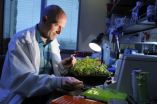(Press-News.org) A Virginia Tech researcher has developed a new way to classify and name organisms based on their genome sequence and in doing so created a universal language that scientists can use to communicate with unprecedented specificity about all life on Earth.
In a paper published in the journal PLoS ONE, Boris Vinatzer proposes moving beyond the current biological naming system to one based on the genetic sequence of each individual organism. This creates a more robust, precise, and informative name for any organism, be it a bacterium, fungus, plant, or animal.
Vinatzer, an associate professor in the College of Agriculture and Life Science's Department of Plant Pathology, Physiology, and Weed Science, suggests a new model of classification that not only crystalizes the way we identify organisms but also enhances and adds depth to the naming convention developed by the godfather of genus, Carl Linnaeus. Scientists worldwide have used the system that Linnaeus created for more than 200 years.
"Genome sequencing technology has progressed immensely in recent years and it now allows us to distinguish between any bacteria, plant, or animal at a very low cost," said Vinatzer, who is also with the Fralin Life Science Institute. "The limitation of the Linnaeus system is the absence of a method to name the sequenced organisms with precision."
Vinatzer does not propose changing the naming convention of existing biological classification. Instead, the new naming system is meant to add further information to classify organisms within named species and to more rapidly identify new ones since the process depends solely on the organism's genetic code.
A genome-based naming system could be particularly helpful to public health officials who live in an age of constant vigilance against biological threats. In his paper, Vinatzer used the anthrax strain that appeared in the wake of the Sept. 11 terrorist attacks as an example of the limitations of the current taxonomy-based system.
Weaponized anthrax frustrated officials as the powder found its way to offices in the United States and the ensuing investigation took months for law enforcement to identify the origin of the original pathogen as the Ames strain.
More than 1,200 strains of anthrax — or Bacillus anthracis — exist. Each one possesses an arbitrary name chosen by researchers that does nothing to illuminate genetic similarities.
With the naming scheme developed by Vinatzer, the name of every single anthrax strain would contain the information of how similar it is to other strains. Using Vinatzer's genome sequence, the Ames strain used in the bioterrorist attack would, for example, be known as lvlw0x and the ancestor of this strain stored at the U.S. Army Medical Research Institute for Infectious Diseases would be known as lvlwlx.
Vinatzer's naming convention would also give researchers the ability to name new pathogens in a matter of days — not months or years — based on their similarities to known pathogens.
The proposed naming process begins by sampling and sequencing an organism's DNA. The sequence is then used to generate a code unique to that individual organism based on its similarity to all previously sequenced organisms.
The advantages to Vinatzer's method over the Linnaeus system are many.
Coded names could be permanent, as opposed to the shifting of names typical in the current biological classification system. Codes could also be assigned without the current lengthy process that is required by analyzing one organism's physical traits compared to another's. Lastly, the sequence could be assigned to viruses, bacteria, fungi, plants, and animals and would provide a standardized naming system for all life on Earth.
Vinatzer cites one plant pathogen — Ralstonia solanacearum — as an example of the roller coaster of rotating name changes that exists in the world of plant pathogens. The pathogen went through three costume changes of names and was originally called Bacillus solanacearum, which then became Pseudomonas solanacearum, and then Burkholderia solanacearum before finally resting on Ralstonia.
Vinatzer has previously used genome sequencing with great success. In 2009, he and a collaborator were able to trace a pathogen that was devastating kiwifruit crops around the world back to China.
Virginia Tech is submitting a patent describing the naming scheme. Vinatzer and his collaborator Lenwood Heath, a professor in the Department of Computer Science in the College of Engineering founded This Genomic Life Inc., which will license the invention to develop it further.
Heath oversaw the development of the bioinformatic pipeline to implement the system. He was interested in collaborating with Vinatzer because of the potential to empower scientists to communicate accurately with one another about biological systems.
"I work in computation, so having the opportunity to impart my knowledge by ordering the organic world through numbered sequences of DNA was fascinating," Heath said. "The mathematical world and the living world are a lot more closely related than we think."
INFORMATION: END
Virginia Tech scientist proposes revolutionary naming system for all life on Earth
New naming system adds further information to classify organisms based on genetic code
2014-02-22
ELSE PRESS RELEASES FROM THIS DATE:
Antibody may be detectable in blood years before MS symptoms appear
2014-02-21
PHILADELPHIA – An antibody found in the blood of people with multiple sclerosis (MS) may be present long before the onset of the disease and its symptoms, according to a study released today that will be presented at the American Academy of Neurology's 66th Annual Meeting in Philadelphia, April 26 to May 3, 2014.
"If our results can be replicated in larger populations, our findings may help to detect MS earlier in a subgroup of patients," said study author Viola Biberacher, MD, with Technical University in Munich, Germany. "Finding the disease before symptoms appear ...
Selenium and vitamin E supplementation over recommended dietary intake may raise PC risk
2014-02-21
In a large clinical trial testing dietary supplements for prostate cancer (PCa) prevention, baseline selenium (Se) status (measured by toenail Se concentration), in the absence of supplementation, was not associated with prostate cancer (PCa) risk. However, when baseline toenail Se concentrations were high, supplementation with high-dose Se almost doubled the risk of high-grade PCa risk among older men, according to a new study published February 21 in the Journal of the National Cancer Institute.
High-dose vitamin E also more than doubled the risk high-grade PCa risk, ...
Selenium and vitamin E supplements can increase risk of prostate cancer in some men
2014-02-21
SEATTLE – A multi-center study led by Fred Hutchinson Cancer Research Center has found that high-dose supplementation with both the trace element selenium and vitamin E increase the risk of high-grade prostate cancer. But importantly, this risk depends upon a man's selenium status before taking the supplements.
These findings, published in Journal of the National Cancer Institute, are based on data from the Selenium and Vitamin E Cancer Prevention Trial, or SELECT, a rigorously executed, randomized and placebo-controlled trial conducted by the SWOG cancer research cooperative ...
Does a diet high in carbohydrates increase your risk of dementia?
2014-02-21
New Rochelle, NY, February 21, 2014—Even small increases in blood sugar caused by a diet high in carbohydrates can be detrimental to brain health. Recent reports in medical literature link carbohydrate calorie-rich diets to a greater risk for brain shrinkage, dementia and Alzheimer's disease, impaired cognition, and other disorders. David Perlmutter, MD, best-selling author of Grain Brain, explores this important topic in a provocative interview in Alternative and Complementary Therapies from Mary Ann Liebert, Inc., publishers. The article is available free on the Alternative ...
NASA's IRIS spots its largest solar flare
2014-02-21
VIDEO:
On Jan. 28, 2014, NASA's newly-launched Interface Region Imaging Spectrometer, or IRIS, observed its strongest solar flare to date.
Click here for more information.
On Jan. 28, 2014, NASA's Interface Region Imaging Spectrograph, or IRIS, witnessed its strongest solar flare since it launched in the summer of 2013. Solar flares are bursts of x-rays and light that stream out into space, but scientists don't yet know the fine details of what sets them off.
IRIS peers into ...
Is a 'buttery' molecule behind cystic fibrosis flare-ups?
2014-02-21
A molecule previously linked to lung injuries in factory workers producing microwave popcorn might play an important role in microbial infections of the lung suffered by people with cystic fibrosis (CF), according to a recent study led by San Diego State postdoctoral researcher Katrine Whiteson. The molecule, known as 2,3-butanedione or diacetyl, can be detected in higher concentrations in CF patients than in healthy ones.
CF patients experience day-to-day persistent coughing and increased mucus production, punctuated by periodic flare-ups of these symptoms, known as ...
New, inexpensive production materials boost promise of hydrogen fuel
2014-02-21
MADISON, Wis. — Generating electricity is not the only way to turn sunlight into energy we can use on demand. The sun can also drive reactions to create chemical fuels, such as hydrogen, that can in turn power cars, trucks and trains.
The trouble with solar fuel production is the cost of producing the sun-capturing semiconductors and the catalysts to generate fuel. The most efficient materials are far too expensive to produce fuel at a price that can compete with gasoline.
"In order to make commercially viable devices for solar fuel production, the material and the ...
Fruit-loving lemurs score higher on spatial memory tests
2014-02-21
DURHAM, N.C. -- Food-finding tests in five lemur species show that fruit-eaters may have better spatial memory than lemurs with a more varied diet.
The results support the idea that relying on foods that are seasonally available and far-flung gives a competitive edge to individuals with certain cognitive abilities -- such as remembering where the goodies are.
In a study appearing in the journal Animal Cognition, researchers Alexandra Rosati at Yale University and Kerri Rodriguez and Brian Hare of Duke compared spatial memory skills across five species of lemurs living ...
NASA sees Tropical Cyclone Guito exit the Mozambique Channel
2014-02-21
NASA's Terra satellite captured a visible image of Tropical Cyclone Guito as it exited the Mozambique Channel and moved into the open waters of the Southern Indian Ocean.
The Moderate Resolution Imaging Spectroradiometer or MODIS instrument that flies aboard NASA's Terra satellite captured a visible image of Tropical Cyclone Guito on Feb. 21 at 07:05 UTC/2:05 a.m. EST and took a visible image of the storm exiting the Mozambique Channel. The image showed bands of thunderstorms were still wrapping around the western quadrant of the storm.
At 0900 UTC/4 a.m. EST, Guito ...
Current ice melt rate in Pine Island Glacier may go on for decades
2014-02-21
A study of the Pine Island Glacier could provide insight into the patterns and duration of glacial melt.
The Pine Island Glacier, a major outlet of the West Antarctic Ice Sheet, has been undergoing rapid melting and retreating for the past two decades. But new research by an international team including researchers from Lawrence Livermore National Laboratory shows that this same glacier also experienced rapid thinning about 8,000 years ago.
Using LLNL's Center for Accelerator Mass Spectrometry to measure beryllium-10 produced by cosmic rays in glacially transported ...
LAST 30 PRESS RELEASES:
Heart-brain connection: international study reveals the role of the vagus nerve in keeping the heart young
Researchers identify Rb1 as a predictive biomarker for a new therapeutic strategy in some breast cancers
Survey reveals ethical gaps slowing AI adoption in pediatric surgery
Stimulant ADHD medications work differently than thought
AI overestimates how smart people are, according to HSE economists
HSE researchers create genome-wide map of quadruplexes
Scientists boost cell "powerhouses" to burn more calories
Automatic label checking: The missing step in making reliable medical AI
Low daily alcohol intake linked to 50% heightened mouth cancer risk in India
American Meteorological Society announces Rick Spinrad as 2026 President-Elect
Biomass-based carbon capture spotlighted in newly released global climate webinar recording
Illuminating invisible nano pollutants: advanced bioimaging tracks the full journey of emerging nanoscale contaminants in living systems
How does age affect recovery from spinal cord injury?
Novel AI tool offers prognosis for patients with head and neck cancer
Fathers’ microplastic exposure tied to their children’s metabolic problems
Research validates laboratory model for studying high-grade serous ovarian cancer
SIR 2026 delivers transformative breakthroughs in minimally invasive medicine to improve patient care
Stem Cell Reports most downloaded papers of 2025 highlight the breadth and impact of stem cell research
Oxford-led study estimates NHS spends around 3% of its primary and secondary care budget on the health impacts of heat and cold in England
A researcher’s long quest leads to a smart composite breakthrough
Urban wild bees act as “microbial sensors” of city health.
New study finds where you live affects recovery after a hip fracture
Forecasting the impact of fully automated vehicle adoption on US road traffic injuries
Alcohol-related hospitalizations from 2016 to 2022
Semaglutide and hospitalizations in patients with obesity and established cardiovascular disease
Researchers ‘listen in’ to embryo-mother interactions during implantation using a culture system replicating the womb lining
How changing your diet could help save the world
How to make AI truly scalable and reliable for real-time traffic assignment?
Beyond fragmented markets: A new framework for efficient and stable ride-pooling
Can shape priors make road perception more reliable for autonomous driving?
[Press-News.org] Virginia Tech scientist proposes revolutionary naming system for all life on EarthNew naming system adds further information to classify organisms based on genetic code





